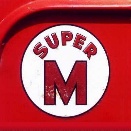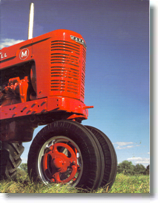
|
Cost:
For a lot of
years the Farmall
M was in
the big leagues--one of the few tractors with the power, capability,
styling,
and popularity to become a lasting symbol of modern farming.
It
was
one of the most successful tractors of all time, which has two
implications
for current sales: One, lots of people still really like
them,
which
drives the price up. Two, many of the 300,000 or so that were
built
are still around, which drives the price down. Typical
auction
prices
for average Ms in running condition are around $1200, here in the
midwest.
A non-running "parts tractor" might go for just a few hundred; a
restored
"show tractor" might go for three or four thousand or even more,
especially if it's
a Super MTA or Super MTA Diesel, the last versions of the M. |
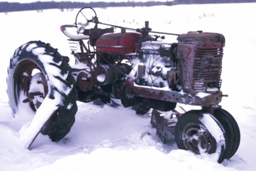 Severely
worn, cracked, or flat tires will drive the value of the tractor down
by
a few hundred dollars; new or nearly new ones will drive it up by a
similar amount. Overall condition of the sheet metal
is another
big
variable, with the front grille being especially likely to be bent up
or missing the little insert near the bottom. Even if that
insert is
gone, check to see if the bottom bar of the grille itself is still
there--the inserts are readily available from aftermarket suppliers,
but if that lower bar has been cut out you'll need more than the insert
to fix it. Severely
worn, cracked, or flat tires will drive the value of the tractor down
by
a few hundred dollars; new or nearly new ones will drive it up by a
similar amount. Overall condition of the sheet metal
is another
big
variable, with the front grille being especially likely to be bent up
or missing the little insert near the bottom. Even if that
insert is
gone, check to see if the bottom bar of the grille itself is still
there--the inserts are readily available from aftermarket suppliers,
but if that lower bar has been cut out you'll need more than the insert
to fix it.
If the gauges, lights, and starting and charging systems work, it'll
save
you the cost of repairing or replacing them later. Optional
equipment like fenders, a belt pulley, the toolbox
that
mounts on the lightbar, wheel
weights, etc., are less expensive to buy already on a tractor
than as separate individual parts. Oil leaks from
beneath
the engine, brakes, axles, or power
takeoff shaft aren't unusual and likely don't mean anything
serious,
but it can be a lot of work to fix them. (Click here for photos and
notes about minor repairs I've made to my 1950 M).
|
Hydraulics:
Most Ms have an
internal "Lift-All" hydraulic system for tractor-mounted implements
like cultivators or a
loader. An
auxiliary hydraulic valve was available as an option to provide
two-way pressure for a remotely-mounted hydraulic cylinder,
such as might be mounted on a trailing implement like a disk or brush hog.
Those valves and related components are frequently
auctioned on eBay, so you can add them to a tractor that didn't previously have
them, but it'll likely cost $150 or more by the time you get it all set
up.
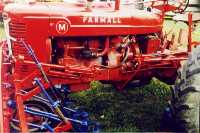 |
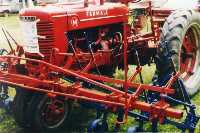 |
|
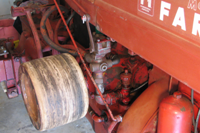 |
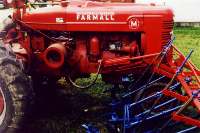 |
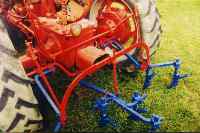 |
|
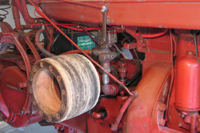 |
|
4-row cultivators on a Farmall M at a tractor show
in Portland,
Indiana.
|
|
Auxiliary
hydraulic valve |
|
Some
Super Ms built in 1953
or 54 (and
regular Ms with after-market equipment--see below) have an
engine-driven
hydraulic pump, as opposed to a transmission-driven pump.
That
means
hydraulic implements can be operated independently of the transmission
clutch, which is a nice feature. The "live" pump also has
more
pressure
and a higher volume flow, so you can lift heavier loads and lift them
faster
than you could with the original transmission-driven pump. If
there
are hydraulic hoses running along the right side of the tractor engine,
from up by the distributor to back under the gas tank, the tractor has
live hydraulics. (The live pump is driven by the timing gear
train,
the same thing that turns the distributor shaft, so the hoses have to
snake
alongside the engine to reach the pump).
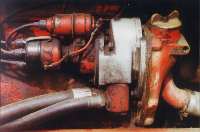 |
The
live hydraulic pump
on a Super M, on the right side of the engine between the distributor
and
the timing gear train. |
If you're going to add a live pump to a tractor that didn't previously
have one, check the spacing of the two top bolts on the distributor
drive (it should be about 3" for older Ms, and about 3-1/2" for newer
ones and Super Ms).
IH pumps
will likely only fit the wider spacing, but you may be able to find a
pump made by an after-market supplier that will fit the narrower
spacing.
|
None of the M series
tractors came
with three-point
hitches, but they can be added as aftermarket items. At least
three ATIS
members have done so, and wrote the following descriptions.
(Note
that all three also have live hydraulic pumps on their
tractors.)
Mike Sloane
wrote:
| |
"...I
bought a used IH
hydraulic pump
that fits in place of the distributor drive between the timing gear and
the distributor (that was $250 from Biewers Antique Acres).
Then
I was fortunate to locate a used hydraulic valve and some other parts
that
were originally from a JD combine, complete with some long curved
handles.
A bracket was made for the valve, and I mounted it on the right axle,
with
the curved handles coming right at hip level when sitting. I
bought
various hoses, adapters, reservoir, and filter from Northern, a
Worksaver
Farmall 3-point hitch kit, and a 2x8" cylinder from CT.
Because
the
valve is a two way valve, I rigged up the lift cylinder for two way
operation
- it is much faster going down that way, but I needed one extra
hose.
If I could have located a used OEM reservoir from a parts tractor, it
would
have made a neater job of it, but I ended up putting the reservoir
under
the seat - the battery remained under the gas tank.
"Does it
work? Yes,
it works fine.
How much did it cost? I think I spent about $800 all
together.
Was that worth it? I don't know. It was interesting
and
maybe
fun to work through the whole process, but to spend $800 on a $1600
tractor
was probably not an efficient operation -- I could probably have bought
a similar 400 with fast hitch and live hydraulics for about the same
money.
Fast hitch adapter kits from 2-point to 3-point are only about
$60.
Also, if I had known, I would have bought the
Saginaw
3-point kit, which comes with 2 cylinders and saved at least $200 -
that
would have made the job much more economically sensible plus I could
have
retained the Farmall swinging drawbar (you can't with the Worksaver kit
unless you buy yet another adapter).
"What
you wind up with is a
Cat II hitch
with no draft sensing. It does have sway control and good
position
control, but the only way to adjust the individual arms is by turning
the
lift screw sleeves -- no hand crank from the operator's seat like a
regular
3-point hitch. Since I only intend to use the hitch with a
brush
cutter, platform lift, or boom crane, none of those deficiencies are of
any consequence, but I could never plow with that
arrangement."
|
Mark Sargent
wrote:
| |
"...We
purchased a 3 point
hitch for our
M (regular old '50 M, but with an M&W live hydraulic pump) last
year
from Saginaw
County
Tractor
Parts. They advertise (with a picture that doesn't
do it
justice)
in Red Power magazine. They are cheaper ($575 at
the time -
$595 now). Includes two cylinders, painted IH red, fits like
a
glove,
impeccable workmanship, Zerk fittings on every bearing service, and
non-slip
material on anything you might use as step. The
cylinders
will
be set up as one way or two way (down pressure) based on what you tell
them you want. The ad says they are the finest--and IMHO they
are
the best--based on the ones we have seen. They have the
roll-over
"ball" type mounting holes in the lift arms to accept Cat I or Cat
II
three-point equipment.
"The
valve is the IH
auxiliary control
valve (two way hydraulics) as depicted in the Operators
Manual.
Ours
uses the belly pump reservoir and has fitting on the control valve to
give
'power beyond' to another valve if we needed to.... The
Saginaw
Three
Point hitch with two cylinders w/down pressure hooked up to the IH
valve
and we have use it extensively (maybe with a tad of abuse) it works
flawlessly.
Never ran into anything it worked at getting up/ down - whatever
-
Boom Pole, 6ft Box Blade, 6ft Bush Hog, Slip scoop-- (BIG
rocks),
and carry all. If will lift the Back end (Down
Force) of
the
Tractor too easily if you know what I mean.
"There
is a lot I'm leaving
out so if you
have any specific questions from a customer's perspective let me know.
I have no conection to Saginaw other than as a satisfied
customer."
|
Stan Bass
wrote:
| |
"I also
purchased my 3
point hitch from Saginaw
Tractor. In regard to its capacity if used with a
single
cylinder
and usefulness with the old belly pump hydraulics, I've gone through
three
stages:
"Stage I
(single cylinder,
no down pressure).
I first hooked it up to just a single cylinder from the one way valve
with
a breather on the top cylinder port and I was able to move 1000lb hay
bales
with it. I once tried to pick up a transmission and axel assy
from
a Super C parts tractor. It couldn't lift it, but if I lifted
it
with something else, it would just barely hold it up in the
air.
I decided not to risk it and used an engine crane to hold it while I
backed
a truck under to haul it off.
"Stage
II (single cylinder,
up/down pressure,
live hyd). When I got tired of not having down pressure and
not
being
able to adjust the hitch when the clutch was in, I upgraded to a live
hydraulic
system from a Series II Super M and added a two spool valve for the 3
point
and 1 remote. As far as cost is concerned, I ended up
with:
225 pump, 100 reservoir, 90 batt box/seat base, 40 seat suspension,
@100
in hydraulic lines, 180 two spool valve that I mounted on the seat box
convenient to right hand. I took one circuit to the 3 point
and
used
the second valve as a remote for the wheels on a cutting disc and the
gate
on a Gehl round baler. Since the reservoir replaces the rear
fuel
tank support, I lost the regulator mounting (which was a blessing in
disguise
since it didn't work anyway) and switched to a 12V alternator at the
same
time. This was an early SM (Series I with the belly pump
hydraulic
system). I got a lot of the parts from either Steel Wheel or
Mathis
Equip that advertise in Red Power.
"Stage
III (twin
cylinders). Well
I finally found a way to damage the hitch. I was picking up
another
tractor (a Farmall B without the motor) from a trailer. I
couldn't
lift it but found I could hold it up if I jacked the trailer up then
let
it down from under the tractor. But didn't get quite enough
clearance
and when I dragged it off the trailer the rockshaft on the hitch bent
so
that one lift arm was a good 7-9 inches lower than the other at the
tip.
I first thought something on the hitch frame was bent or broken, but
the
frame was fine, just the rockshaft twisted. So I blocked the
low
arm and used the down pressure to straighten out the rockshaft forcing
it the other way. Then I went and got the second cylinder
that
had
been collecting dust and routed new hydraulic lines to feed both
cylinders
together. I tried again to lift the parts B tractor and this
time
with the extra capacity I lifted it right off the ground and drove away
with it."
|
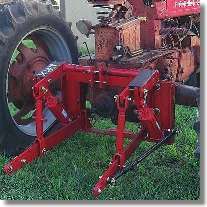 |
A
Saginaw
hitch on a Farmall 400, photographed and owned by ATIS member
Goodwrench.
Click on the picture to go to a larger, higher-resolution image. |
| Power
Take-Off and Torque Amplifier: |
| The
Super
MTAs, built only
in 1954, were the first Farmalls to have a live power
takeoff.
Live
power wasn't a factory option on older Ms and Super Ms, but an
after-market
hand clutch was available that provided a live pto. Many
tractors
still have those clutches (made by M&W), mounted over the left
brake
housing, but parts for them are hard to come by. ATIS member
Stan
Bass recently had to fabricate new disks for the M&W clutch on
his
Super M, after being unable to find enough replacement disks.
Here's
his description, as posted to the ATIS Farmall list: |
| |
"For
those of you that
recall, last fall
I posted a couple of questions on the main list about repairing the
hand
clutch on my Super M. The update is that it now has new
clutch
discs
and appears to be working great :-)
"We
measured the NOS disc I
found and drew
it in autocad, fed that through some other magic (I lost track)
eventually
to the CNC mill controller. We did several test cuts out of
wood
until we matched the NOS disc perfectly. We bought a large sheet of the
clutch material and milled them out. The material was very
hard
on
the cutter bits, a carbide bit barely lasted through one disc if we
were
lucky. I put the tractor back together the first weekend
using 2
new discs and the NOS disc (since we matched the disc up so well, I
wasn't
worried about being able to reproduce the NOS disc). Doing
just
small
quantities like this it ended up costing about $100 per disc.
"My
tractor had apparently
sat for a long
period at some point as the metal parts inside of the hand clutch
(especially
the brake drum which has the teeth that mate to the discs) were rusted
and pitted. What surprised me was that the old fibre discs
were
not
worn down in their thickness, but their teeth had been chewed
off!
My M was just driving off the stubs left on the teeth from the last
disc.
The teeth on the fibre discs are apparently designed with very tight
clearances
so I spent most of my time with a file removing scale and getting a
good
surface on the teeth in the drum before they would slide in."
|
| Stan
also
found out that M&W
is still operating and may be able to help with information, and can be
reached at (800) 221-2855.
Super
MTAs also introduced
the "Torque
Amplifier" (hence the "TA" designation), an IH innovation used on many
following Farmall series tractors. It was a planetary gearset
that
let the operator shift to a lower range while on the go, increasing
torque
and decreasing ground speed. If you're looking at an MTA,
check
to
be sure the TA works--you'll often see tractors advertised as having a
"good TA" or "bad TA," or something like that. They can be
rebuilt
or replaced if they're worn out, and are readily available from
suppliers
such as those listed below.
|
| Starting
and Running: |
Most
Ms have
an electric starting
and lighting system, but not all do. Many have been converted
to
12-volt systems, but the original 6-volt systems will work fine if the
tractor is tuned up well and if the temperatures aren't bitterly cold.
If
you're buying a new 6-volt battery, get the biggest one, with the most
"cold
cranking
amps" (CCA), that will fit in the battery box. The wiring
harnesses on old tractors are often in pretty bad shape, but they're
fairly simple to replace since everything is accessible.
Check
out
Robert
Melville's Farmall wiring diagrams, and suppliers like
Brillmans, Rhode Island Wire or
OEM
Tractor Parts for original-looking wire and components.
The
brake
pedals should have
about 1-1/4" of free play--the distance you can push the pedals in
before
the brakes start to take hold. They should be matched, so
that
both
brakes engage at the same time when the pedals are latched
together. Look for oil accumulation beneath the brake
housings,
which is a sign of oil leaking past the seals and soaking the brake
bands. The clutch pedal should have between 1/2" and 1" of
free
play.
I've
bought two Ms over the years and taking the tractor for a road test was
a clincher both times--it's just a lot of fun to hear that smooth
Farmall hum and to watch the world go by from up there. And
it's an opportunity to test the clutch and the gears, and to
listen for unusual sounds from the transmission, and it's a decent way to judge engine lugging
power as you start out in 5th gear from a dead stop. But be
careful: Farmall
Ms are fast
in 5th gear, like 16 or 17 miles an
hour.
When
you're up high on that seat, on a vehicle with no suspension,
that's cruising right along. It's no problem on a smooth
road,
but
hitting a bump or a pothole at that speed could bounce you right off
the
seat. Start slowly and get comfortable with the tractor, the
steering,
the brakes, and the road before you try the 5th-gear test.
As
someone else on the AT
forum posted,
Ms are notorious for having a worn worm gear or sector gear in the
steering,
which can cause the front wheels to shake in high gear. You
can
check
for this when driving the tractor. Even at low speed, you'll
be
able
to tell if there's a lot of free play in the steering--i.e., if you can
turn the steering wheel quite a bit without actually turning the front
wheels, or if the front wheels turn back and forth a bit on their
own. |
| |
Narrow-front
Ms can be
hard to steer when
stopped or when moving very slowly, but are usually fine once you're
moving
faster. Backing into a tight space can be a challenge, since
when
you're half turned around with only one hand on the wheel, it can be
hard
to put much weight into steering. I think old Farmalls tend
to be
harder to steer than old John Deeres, since the Farmall engine is right
up front by the front wheels, while Deere engines are back close in to
the rear axle. (I think this is also why rear-wheel weights
seem
to be more common on Farmalls than on comparably-sized John Deeres,
since
that Deere engine placement helps traction).
A
spinner knob on the
steering wheel can
help, and is hugely fun to use when turning the tractor around at the
end
of a row, but it can also whack your hand good and hard if the front
wheels
hit a rock or a furrow or something, and the steering wheel suddenly
spins.
None of the Ms came with power steering, although there were
aftermarket
companies like Behlen and Char-Lynn that made power-steering pumps for
them. I'd think that Farmall parts suppliers like
Bates
Corporation (Bourbon, IN, 800-248-2955),
Steel
Wheel Ranch (Everest, KS, 785-548-7437),
Carter
and Gruenewald (Brooklyn, WI, 608-455-2411),
Sam's
Tractor Parts (Noxapater, MS, 888-333-1690), Mathis Equipment
(Cairo,
MO, 816-295-4456), or Berkshire Implement (Royal Center, IN,
219-643-3115)
would have some of those pumps for sale.
I don't
think a wide front
end would make
much difference in the ease or difficulty of steering, but they're
likely
to be available from those same suppliers if you wanted to try it, or
if
you wanted to convert for other reasons.
|
| One
other
thing you might
check: Ms sometimes had a problem in the rear-end
transmission.
There are two big "bull gears" in the final drive, centered on the rear
axles, one on each side.
The
bearings
that support these gears wear out sometimes, and so a ball
bearing would drop down and get caught between the gear and
the
housing, and punch through.
The problem could be fixed, and wasn't all that common to begin with,
so
unless there's a leaking patch in the bottom of the rear
end your tractor is probably fine. Just thought I'd mention
it
as
long as we're talking Ms. |
|

